Effects of Green Plants on the Indoor Environment and Wellbeing in Classrooms—A Case Study in a Swedish School
Abstract
:1. Introduction
2. Materials and Methods
2.1. Setting
2.2. The Design Process
- It should be a robust design and be safe to use in classrooms by teenagers.
- It should be a watertight design, eliminating any possible leakage of water into the classrooms.
- It should be designed to be low maintenance with an automatic irrigation system and a water tank that can accommodate at least one week of water usage.
- Materials should be chosen to be as sustainable as possible.
- The cost of the design should be as low as possible since it is intended to be used in school environments, which often have a limited budget.
- Waterfall: This design is made of metal sheets and includes three trails of water at three height levels that are slightly tilted. The green plants are located on the trails, just as they were purchased. No soil is needed. Water is pumped from a water tank at the bottom of the stand to the top trail. Then, by gravitational force, the water flows to the other side of the trail and then falls down to the trail below. The water flow continues, passing through all three trails and then back to the water tank. When passing through the trails, the water flows through all plants and is absorbed from the bottom of the plants by capillarity forces. A timer connected to the water pump regulates the duration of the water flow.
- Green Working Space: This stand is made of wood and includes five levels of wooden trays: four on each side and a long one on the top. Each wooden tray is sealed with a plastic sheet and filled with soil. The plants are planted in these different wooden trays. In the centre of the stand, there is a seating place, and a wooden board above that if folded down creates a working place that includes a table. Water is pumped from a water tank at the bottom of the stand to the top tray. Then, by gravitational force, the water flows through diffused pipes along the trays to the bottom tray, and by that irrigates all the plants. A timer connected to the water pump regulates the duration of the water flow.
- Plants Pillars: The plants are planted in soil, each in its own sealed plastic sewage pipe. A water tank is located at the bottom of the stand. Water is lifted to the top of the stand using a water pump and then runs down due to gravity and fills plastic bottles located within the stand at different levels. The water is transported by capillarity forces from the plastic bottles to the soil of each sewage pipe via a cotton rope. The pillars are made of Cardboard and wood and stand on four small wheels. They can be moved around the class and are connected to the electricity via electric contacts sitting along with the fluorescent lamps (see Figure 3). A timer connected to the water pump regulates the amount of water provided.
- Plants Picture: This design resembles a wall picture. It is made of wood and includes LED lamps around the frame for creating a cosy atmosphere around the stand. The plants are planted in soil within long plastic plant boxes. The plant boxes are located at five height levels, with two boxes at each level. The plant boxes are slightly tilted toward the viewer so the plant can stick out from the stand and conceal the boxes above them. Water is pumped from a water tank at the bottom of the stand to its top. Then, by gravitational force, flow down in drip irrigation pipes from the top plant box to the lowest and by that provide water to the plants in all the boxes. A timer connected to the water pump regulates the amount of water provided.
2.3. The Green Plants
- They should be part of the NASA list of air purification plants [5].
- They should be part of the list of allergy-free indoor plants [24].
- They should have air-purifying abilities.
- It was important to use plants that are robust and not sensitive to changes in conditions, e.g., soil moisture level.
- They should be available in the local market.
2.4. Measurements of the Indoor Environment
- A robust IP67 box with 3D printed casings. The IP67 box shields the sensors from any external interference but at the same time allows them to collect the environmental information through its shell.
- An SPS30 optical particle sensor that uses laser scattering and Sensirion’s contamination resistance technology. It measures both PM2.5 and PM10.
- A Sensair S8 carbon dioxide sensor (CO2) based on infrared technology.
- A BME680 air quality sensor that provides measurements of ambient air temperature, relative humidity and barometric pressure.
- A VEML6030 ambient light sensor with a digital 16-bit resolution.
- A Raspberry Pi 3 A+ as the main hardware (small computer). It has built-in 802.11b/g/n capabilities and can utilize and read a wide range of different sensor hardware.
2.5. Final Energy Modelling
2.6. Questionnaire
2.7. Interviews with Teachers
3. Results
3.1. Indoor Environment
3.1.1. Hourly Variations in Indoor Temperature and CO2 Levels
3.1.2. Indoor Temperature
3.1.3. CO2 Levels
3.1.4. Humidity, Light Level and Airborne Particles
3.2. Final Energy Modelling
3.3. Plant Stand Design Performance
3.4. Student Well-Being
3.5. Teachers’ Experiences
3.5.1. A Feeling of Freshness and Cosiness
[I] think if I were to ask the students, they would probably say no […] I may have felt it a little at first, but it was very difficult to know what is what, if you found it cosier, if that made it feel like it was a little better or if it really was the air that got better. It’s a little hard to tell the difference, somehow.
And like I said, they are teenagers so they are a little sceptical at times. Just like I said earlier, ‘But can this really be something that can be measured?’ and ‘What do they see in this?’ and ‘We’ll read out letters, can it really do anything?’ [laugh]. Yes. It is in itself, I think, a little healthy that they are a bit questioning.
3.5.2. A Sustainable Design for Plants and Students
It has messed a lot with the irrigation systems, and so on. Because it was part of the project [to test different systems], that it [the plants] would be self-watering, you would only need to fill the large containers at regular intervals and so on. […] They were like the pillars of our classroom […] And it has been a lot of trouble, so [names the researcher] has been here quite a lot in the evenings and fixed [laughs] to make it work. So it turned out that it… That [responsibility] has probably been a little more on him [laughs] than I thought at the beginning, that the students could fix with the plants.
… And in the lessons, there are some like, ‘yes, but I have to stand for a while, I’m so restless’. Yes, but go and stand there at that standing table [beside the plant pillars] and work. Bring your Ipad or your math books and stand there and work.’ It has become a natural workplace that you would like to have more of.
3.5.3. Involvement in Taking Care of the Plants
“Because everything has worked so well, the students have had a commitment spontaneously, ’but that plant doesn’t seem to be doing well, should we not do something?’ But, they are a bit like, ‘yes, but we’ll go and see what it could be due to’.”
4. Discussion
4.1. Results Discussion
4.2. Methodological Considerations
4.2.1. Indoor Measurements
4.2.2. The Questionnaire Study
4.2.3. The Qualitative Study
4.2.4. Impact of the COVID-19 Pandemic
5. Conclusions
- Ventilation flow in buildings could be reduced with the use of indoor green plants, and thus reduce ventilation heat losses, or, alternatively, green plants could be used to improve air quality in buildings with poor ventilation.
- It is important that the plant stand provides enough water, fertilizer and light to keep the plants healthy since withered and dead plants may have a worse impact than no plants.
- The plant stands should be designed to reduce maintenance work, particularly irrigation. The dimensioning of the irrigation system is crucial for the survival of indoor plants.
- Plants and plant stands can be used to create spaces for different activities in the classroom, such as relaxing corners. Future projects could involve pupils and teachers in the design from this perspective.
- Pupils should preferably be involved in taking care of the plants. Researchers must be clear about what the teachers and pupils are allowed to do and encourage the use of the plants in education, for example, to use indoor plants as a way to work with the SDGs.
- Plants might contribute to a more pleasant classroom environment, better indoor climate and increased well-being, but more research with a long follow-up time is needed.
Author Contributions
Funding
Institutional Review Board Statement
Informed Consent Statement
Data Availability Statement
Acknowledgments
Conflicts of Interest
References
- Custovic, A.; Taggart, S.C.O.; Woodcock, A. House dust mite and cat allergen in different indoor environments. Clin. Exp. Allergy 1994, 24, 1164–1168. [Google Scholar] [CrossRef] [PubMed]
- Sandstedt, E.; Hallberg, M. Sjuka Hus-Problem i Svenska Grundskolor: En Kommunstudie (Sick House Problems in Swedish Primary and Secondary Schools: A Municipal Study); Institutet för Bostads-och Urbanforskning, Uppsala Universitet: Gävle, Sweden, 2003. [Google Scholar]
- The Public Health Agency of Sweden (Folkhälsomyndigheten). 2014:18 Folkhälsomyndighetens allmänna råd om ventilation (The Swedish Public Health Agency’s general advice on ventilation). In FoHMFS Folkhälsomyndighetens Författningssamling; Blom, N., Ed.; Fritzes, Norstedts Juridik AB/Fritzes: Stockholm, Sweden, 2014. [Google Scholar]
- Smedje, G. Innemiljön i Svenska Skolor (The Indoor Environment in Swedish Schools); Inomhusklimat Conference 2009; Örebro University Hospital: Örebro, Sweden, 2009. [Google Scholar]
- Wolverton, B.C.; Douglas, W.L.; Bounds, K. A Study of Interior Landscape Plants for Indoor Air Pollution Abatement; NASA, John C Stennis Space Center: Mississippi City, MS, USA, 1989. [Google Scholar]
- Krawczyk, D.; Rodero, A.; Gładyszewska-Fiedoruk, K.; Gajewski, A. CO2 concentration in naturally ventilated classrooms located in different climates—Measurements and simulations. Energy Build. 2016, 129, 491–498. [Google Scholar] [CrossRef]
- Siskos, P.A.; Bouba, K.E.; Stroubou, A.P. Determination of selected pollutants and measurement of physical parameters for the evaluation of indoor air quality in school buildings in Athens, Greece. Indoor Built Environ. 2001, 10, 185–192. [Google Scholar] [CrossRef]
- The Public Health Agency of Sweden (Folkhälsomyndigheten). Inomhusmiljön i Skolan Ett Inationellt Tillsynsprojekt 2014–2015 (The Indoor Environment in the School an International Supervision Project 2014–2015); Carlson, J., Ed.; Fritzes: Stockholm, Sweden, 2015. [Google Scholar]
- Han, K.-T.; Ruan, L.-W. Effects of indoor plants on self-reported perceptions: A systemic review. Sustainability 2019, 11, 4506. [Google Scholar] [CrossRef] [Green Version]
- Chatzidiakou, L.; Mumovic, D.; Summerfield, A.J. What do we know about indoor air quality in school classrooms? A critical review of the literature. Intell. Build. Int. 2012, 4, 228–259. [Google Scholar] [CrossRef]
- Wolverton, B.C. Renare Luft Med Växter: 50 Rumsväxter Som ger Friskare Inomhusmiljö; B. Wahlström: Stockholm, Sweden, 1997. [Google Scholar]
- Gifford, R. Environmental psychology matters. Annu. Rev. Psychol. 2014, 65, 541–579. [Google Scholar] [CrossRef] [Green Version]
- Hall, C.; Knuth, M. An update of the literature supporting the well-being benefits of plants: A review of the emotional and mental health benefits of plants. J. Environ. Hortic. 2019, 37, 30–38. [Google Scholar] [CrossRef]
- Raanaas, R.K.; Evensen, K.H.; Rich, D.; Sjøstrøm, G.; Patil, G. Benefits of indoor plants on attention capacity in an office setting. J. Environ. Psychol. 2011, 31, 99–105. [Google Scholar] [CrossRef]
- Hähn, N.; Essah, E.; Blanusa, T. Biophilic design and office planting: A case study of effects on perceived health, well-being and performance metrics in the workplace. Intell. Build. Int. 2020, 13, 241–260. [Google Scholar] [CrossRef]
- Bringslimark, T.; Hartig, T.; Patil, G.G. The psychological benefits of indoor plants: A critical review of the experimental literature. J. Environ. Psychol. 2009, 29, 422–433. [Google Scholar] [CrossRef]
- McCullough, M.B.; Martin, M.D.; Sajady, M.A. Implementing green walls in schools. Front. Psychol. 2018, 9, 619. [Google Scholar] [CrossRef] [PubMed] [Green Version]
- Najafi, N.; Keshmiri, H. The relationship between classroom indoor plants and happiness of female high school students. Int. J. Sch. Health 2019, 6, 1–4. [Google Scholar] [CrossRef]
- Pichlhöfer, A.; Sesto, E.; Hollands, J.; Korjenic, A. Health-Related Benefits of Different Indoor Plant Species in a School Setting. Sustainability 2021, 13, 9566. [Google Scholar] [CrossRef]
- Pointon, P. Students’ views of environments for learning from the primary to the secondary school. Int. J. Educ. Res. 2000, 33, 375–382. [Google Scholar] [CrossRef]
- Warne, M.; Snyder, K.; Gådin, K.G. Promoting an equal and healthy environment: Swedish students’ views of daily life at school. Qual. Health Res. 2013, 23, 1354–1368. [Google Scholar] [CrossRef]
- Han, K.-T. Influence of limitedly visible leafy indoor plants on the psychology, behavior, and health of students at a junior high school in Taiwan. Environ. Behav. 2009, 41, 658–692. [Google Scholar] [CrossRef] [Green Version]
- Doxey, J.S.; Waliczek, T.M.; Zajicek, J.M. The impact of interior plants in university classrooms on student course performance and on student perceptions of the course and instructor. HortScience 2009, 44, 384–391. [Google Scholar] [CrossRef]
- The Asthma and Allergy Association. Bra Växtval för Personer Med Allergi och Annan Överkänslighet (Good Plant Selection for People with Allergies and Other Hypersensitivity); The Asthma and Allergy Association: Stockholm, Sweden, 2016. [Google Scholar]
- Currie, C.; Zanotti, C.; Morgan, A.; Currie, D.; de Looze, M.; Roberts, C.; Samdal, O.; Smith, O.R.F.; Barnekow, V. Social Determinants of Health and Well-Being among Young People. Health Behaviour in School-Aged Children (HBSC) Study: International Report from the 2009/2010 Survey; WHO Regional Office for Europe: Copenhagen, Denmark, 2012; p. 271. [Google Scholar]
- Currie, C.; Gabhainn, S.N.; Godeau, E. The Health Behaviour in School-aged Children: WHO Collaborative Cross-National (HBSC) study: Origins, concept, history and development 1982–2008. Int. J. Public Health 2009, 54, 131–139. [Google Scholar] [CrossRef]
- Currie, C.; Roberts, C.; Morgan, A.; Smith, R.; Settertobulte, W.; Samdal, O.; Rasmussen, V.B. (Eds.) Young People’s Health in Context: Health Behaviour in School-Aged Children (HBSC) Study: International Report from the 2001/2002 Survey; WHO Regional Office for Europe: Copenhagen, Denmark, 2004. [Google Scholar]
- Braun, V.; Clarke, V. Using thematic analysis in psychology. Qual. Res. Psychol. 2006, 3, 77–101. [Google Scholar] [CrossRef] [Green Version]
- Moya, T.A.; van den Dobbelsteen, A.; Ottelé, M.; Bluyssen, P.M. A review of green systems within the indoor environment. Indoor Built Environ. 2019, 28, 298–309. [Google Scholar] [CrossRef]
- World Health Organization. Air Quality Guidelines for Europe; World Health Organization, Regional Office for Europe: Copenhagen, Denmark, 2000. [Google Scholar]
- Kim, H.-H.; Yeo, I.-Y.; Lee, J.-Y. Higher attention capacity after improving indoor air quality by indoor plant placement in elementary school classrooms. Hortic. J. 2020, UTD-110. [Google Scholar] [CrossRef] [Green Version]
- Fjeld, T. The effect of interior planting on health and discomfort among workers and school children. HortTechnology 2000, 10, 46–52. [Google Scholar] [CrossRef] [Green Version]
- Han, K.-T. Influence of passive versus active interaction with indoor plants on the restoration, behaviour and knowledge of students at a junior high school in Taiwan. Indoor Built Environ. 2018, 27, 818–830. [Google Scholar] [CrossRef]
- Grubaugh, S.; Houston, R. Establishing a classroom environment that promotes interaction and improved student behavior. Clear. House 1990, 63, 375–378. [Google Scholar] [CrossRef]
- Lyons, C.; Brown, T.; Bourke-Taylor, H. The Classroom Environment Questionnaire (CEQ): Development and preliminary structural validity. Aust. Occup. Ther. J. 2018, 65, 363–375. [Google Scholar] [CrossRef]
- Maich, K.; Davies, A.W.J.; Van Rhijn, T. A relaxation station in every location. Interv. Sch. Clin. 2018, 54, 160–165. [Google Scholar] [CrossRef] [Green Version]
- Burke, K.; Burke-Samide, B. Required Changes in the classroom environment It’s a Matter of Design. Clear. House A J. Educ. Strateg. Issues Ideas 2004, 77, 236–240. [Google Scholar] [CrossRef]
- Gravetter, F.; Wallnau, L. Statistics for the Behavioral Sciences; Thomson Learning. Inc.: Belmont, CA, USA, 2007. [Google Scholar]
- Stevens, J.P. Applied Multivariate Statistics for the Social Sciences; Routledge: London, UK, 2012. [Google Scholar]
- Tabachnick, B.G.; Fidell, L.S.; Ullman, J.B. Using Multivariate Statistics; Pearson: Boston, MA, USA, 2007; Volume 5. [Google Scholar]
- Thatcher, A.; Adamson, K.; Bloch, L.; Kalantzis, A. Do indoor plants improve performance and well-being in offices? Divergent results from laboratory and field studies. J. Environ. Psychol. 2020, 71, 101487. [Google Scholar] [CrossRef]
- Graneheim, U.H.; Lundman, B. Qualitative content analysis in nursing research: Concepts, procedures and measures to achieve trustworthiness. Nurse Educ. Today 2004, 24, 105–112. [Google Scholar] [CrossRef]

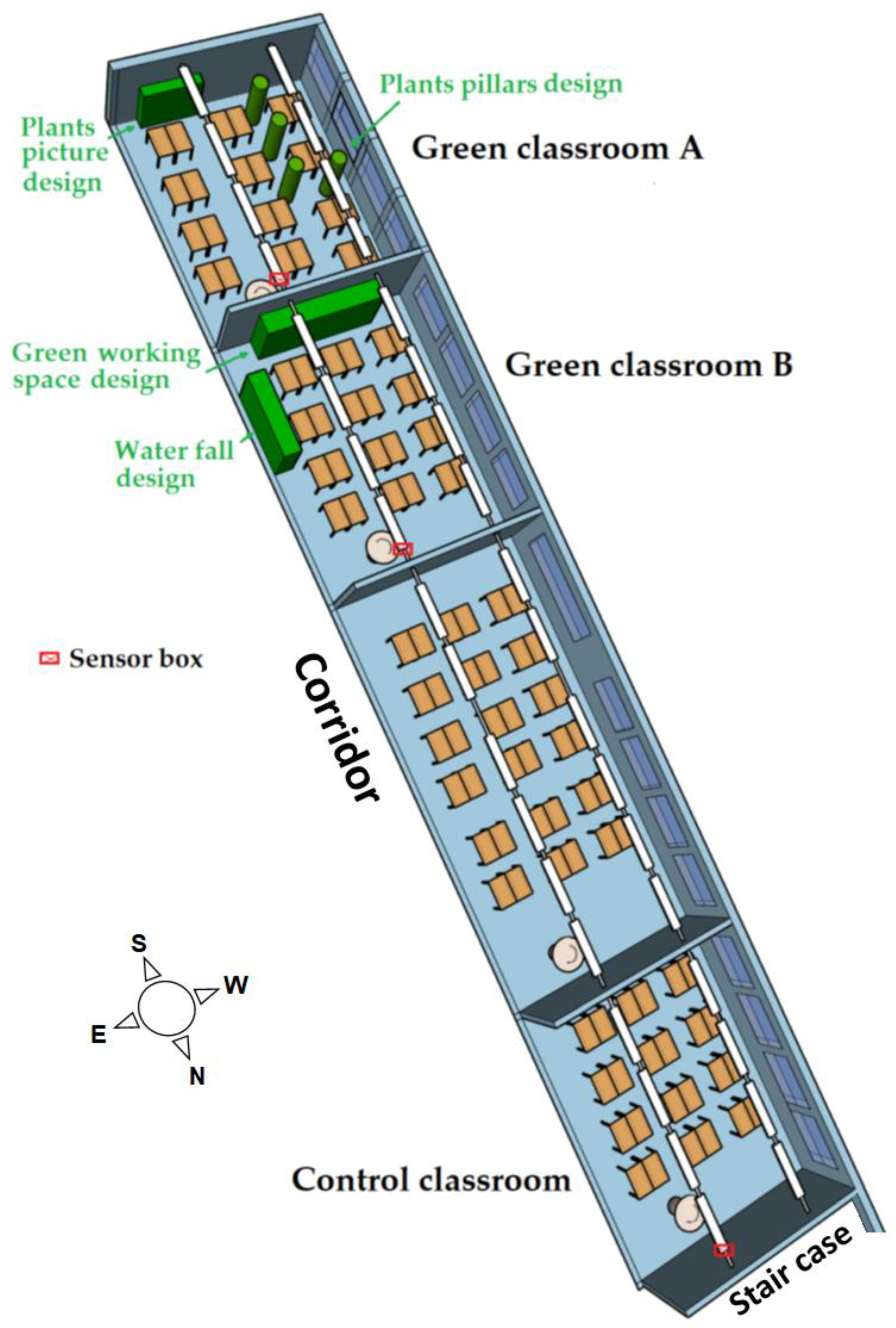
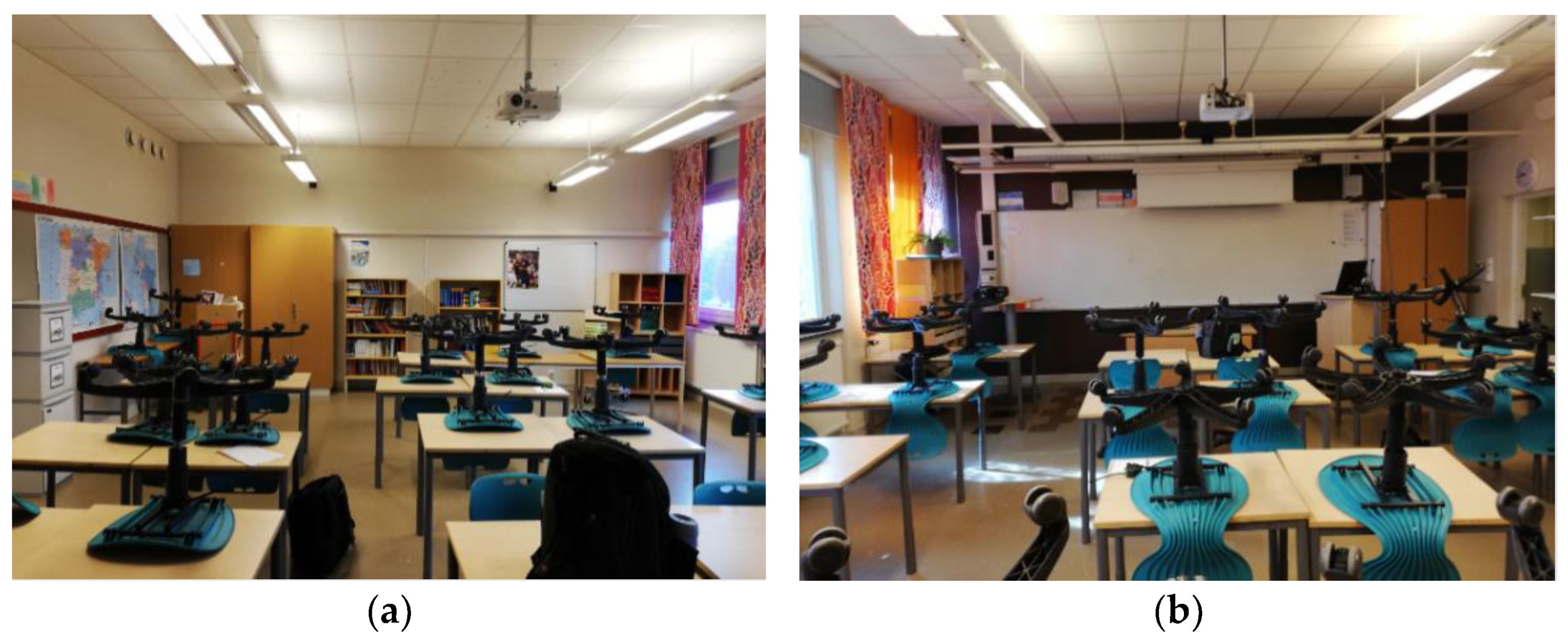

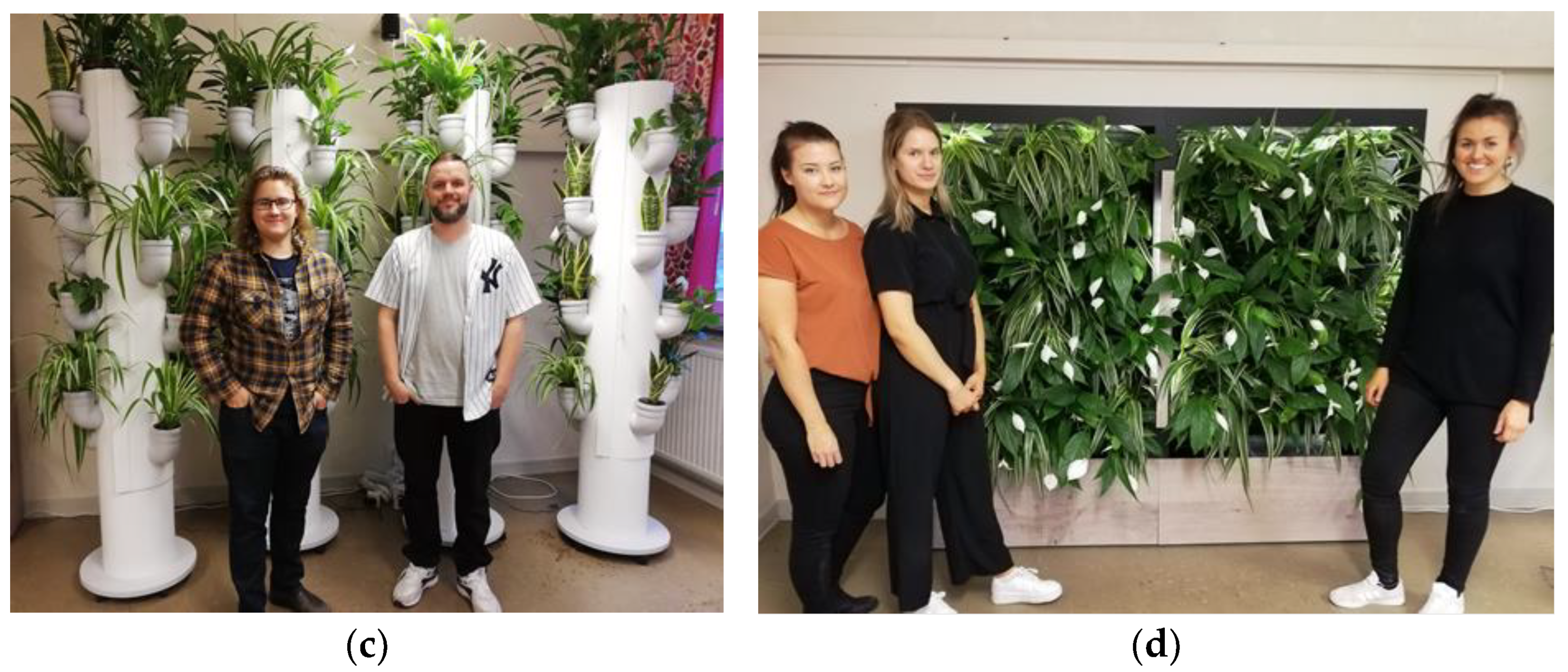


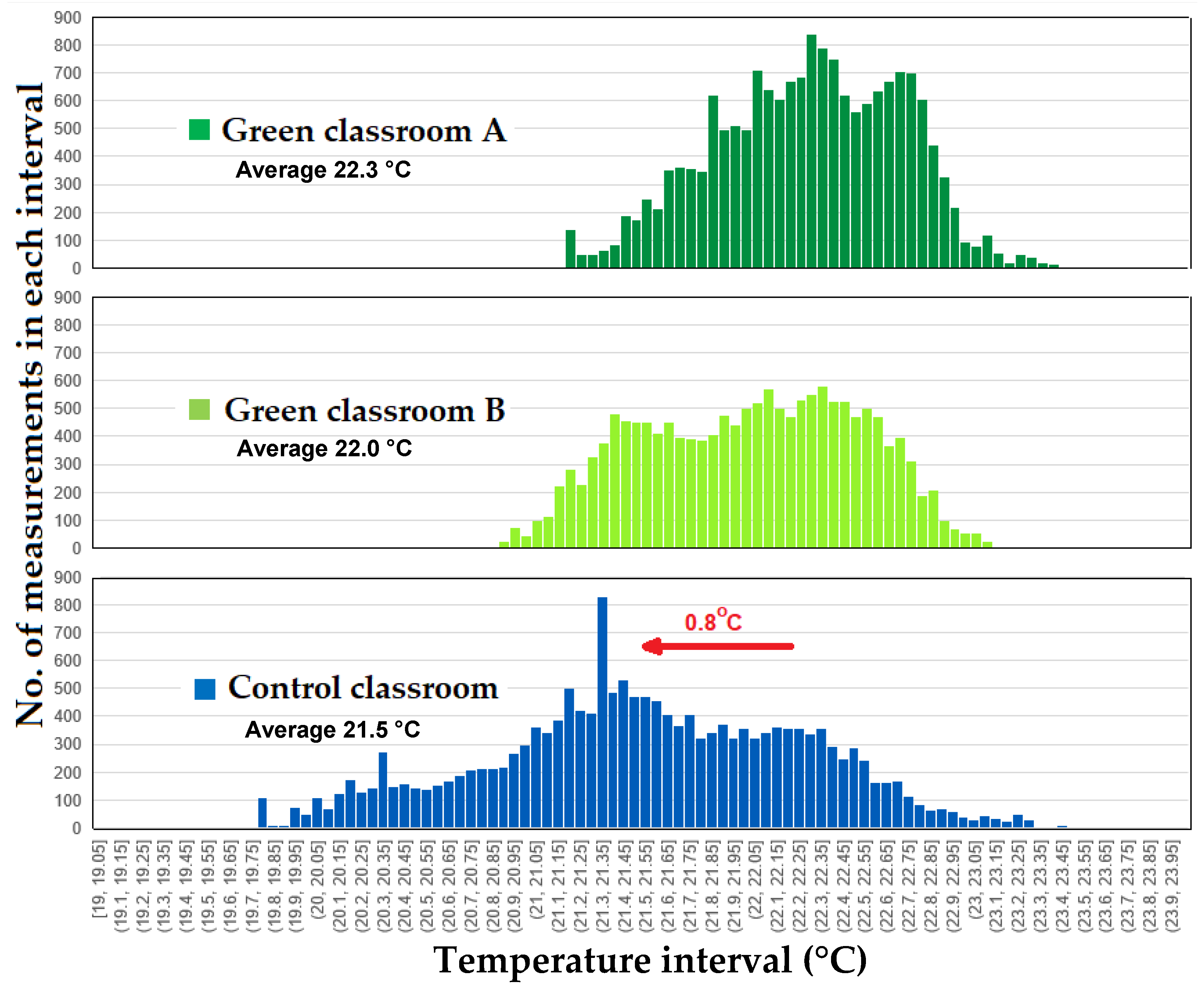
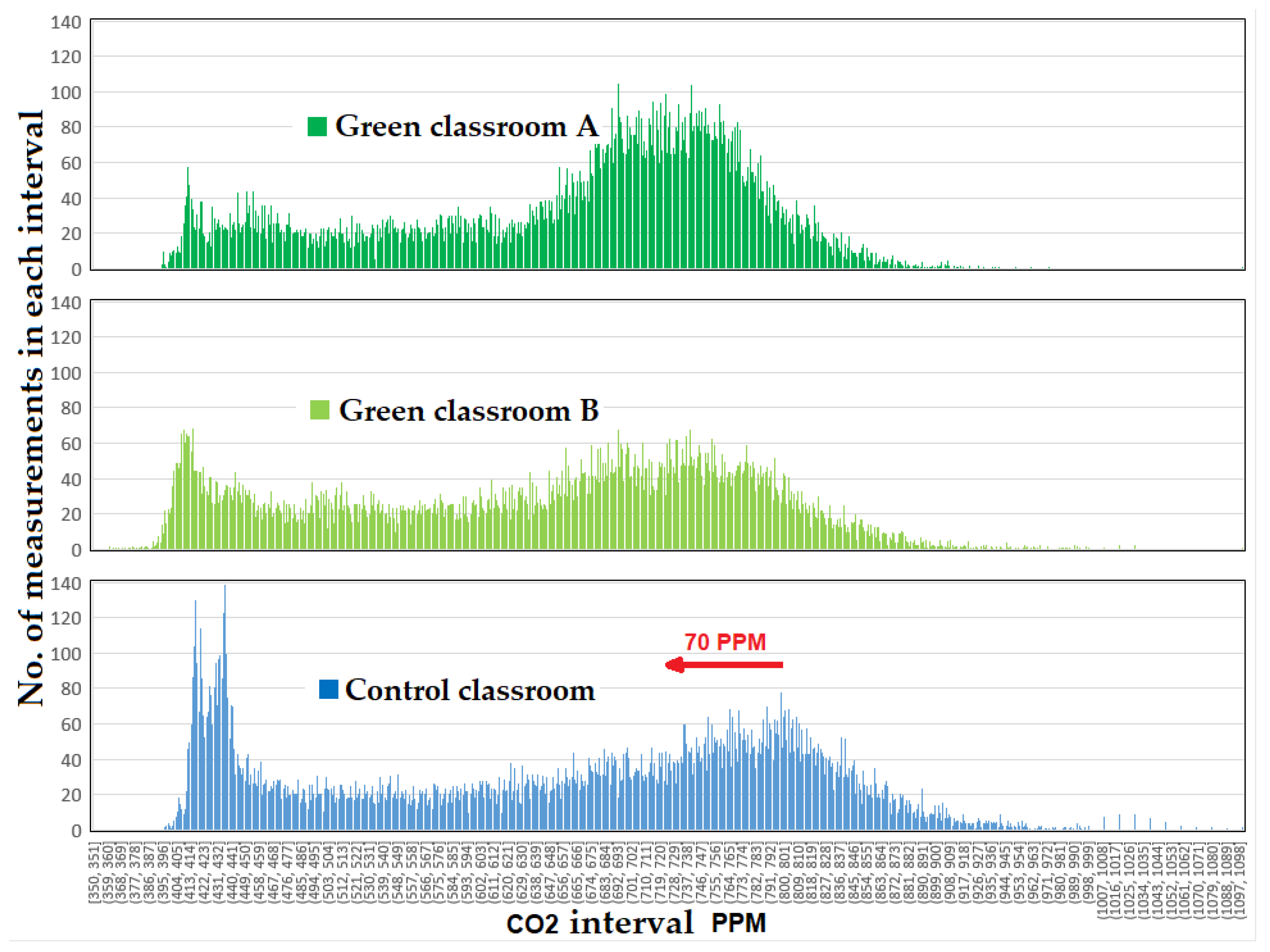


| U Value | School Time | Night Time | |||
|---|---|---|---|---|---|
| External walls | 0.265 | W/(m2 K) | Ventilation flow | 7 L/(s person) | 0.1 L/(s m2) |
| Windows | 1.2 | W/(m2 K) | Body heat | 90 W/person | 0 W/m2 |
| External roof | 0.179 | W/(m2 K) | Electricity use | 9.4 W/m2 | 0 W/m2 |
| Planstand | Advantages | Disadvantages |
|---|---|---|
| Waterfall | This plant stand has an outstanding function. It is easy to replace plants because they remain in their pots. The plant container is “clean” (simple, clean and functional) throughout its construction. | There are fingerprints on the sheet metal sides. From the beginning, there was a filter (coffee filter), but it is gone, and the soil washed into the tank. Sometimes a leaf settles over the drain hole and then there can be water flooding. |
| Green Working Space | It is experienced as very beautiful. People who enter the classroom react. The standing table and seat are used all the time and are much appreciated by the pupils. They may take turns using them. Convenient with only one power connection. | The water supply was low in the three lowest plants levels. On these, only the Saint George’s sword survived. It would have been better if the drip irrigation was not buried in the soil so that it would have been possible to see if they were providing enough water. |
| Plants Pillars | Everyone thinks it is a nice design. | In the beginning, the pumps did not work due to a gap in the transformer. The plants began to wither immediately. After the electricity was moved from the floor to the top of the plant container, the irrigation seemed to work. The plant stand is large for the space, which makes it difficult to furnish well. |
| Plants Picture | The drip pipes are located on top of the soil and water better than in the large Green Working Space plant stand design. | The long plastic plant pots are hung in metal hooks that have damaged the pots. The design of the plant stand makes it difficult to use, partly due to having two water tanks, and also because the water tank and electricity, located under the bottom compartment, are difficult to access. |
| Friedman Test | ||||
|---|---|---|---|---|
| Median (IQR) | n (df) | Chi-Square | p-Value | |
| Psychosomatic problems (PSP) 1 | 39 (2) | 7.09 | 0.03 | |
| Measurement 1 | 20 (16–25) | |||
| Measurement 2 | 19 (16–24) | |||
| Measurement 3 | 17 (14–21) | |||
| Measurement 4 | 19 (15–23) | |||
| Positive health 2 | 39 (2) | 0.83 | 0.66 | |
| Measurement 1 | 30 (26–34) | |||
| Measurement 2 | 31 (27–35) | |||
| Measurement 3 | 31 (28–34) | |||
| Measurement 4 | 31 (27–33) | |||
| School stress 3 | 39 (2) | 8.82 | 0.01 | |
| Measurement 1 | 3 (2–3) | |||
| Measurement 2 | 3 (3–4) | |||
| Measurement 3 | 3 (2–3) | |||
| Measurement 4 | 3 (2–4) | |||
| Worry about climate change 3 | 39 (2) | 11.74 | 0.003 | |
| Measurement 1 | 2 (2–3) | |||
| Measurement 2 | 2 (1–3) | |||
| Measurement 3 | 2 (1–2) | |||
| Measurement 4 | 1 (1–2) | |||
| Worry about infectious disease 3 | 39 (2) | 14.4 | 0.001 | |
| Measurement 1 | 2 (1–3) | |||
| Measurement 2 | 2 (1–3) | |||
| Measurement 3 | 3 (2–4) | |||
| Measurement 4 | 3 (2–4) | |||
| Worry about unemployment 3 | 39 (2) | 2.74 | 0.26 | |
| Measurement 1 | 2 (1–2) | |||
| Measurement 2 | 1 (1–2) | |||
| Measurement 3 | 1 (1–2) | |||
| Measurement4 | 1 (1–3) | |||
| Worry about war 3 | 39 (2) | 6.32 | 0.04 | |
| Measurement 1 | 2 (1–3) | |||
| Measurement 2 | 2 (1–2) | |||
| Measurement 3 | 2 (1–2) | |||
| Measurement 4 | 1 (1–2) | |||
| Sick absence 4 | 39 (2) | 3.8 | 0.15 | |
| Measurement 1 | 2 (2–2) | |||
| Measurement 2 | 2 (1–2) | |||
| Measurement 3 | 2 (2–2) | |||
| Measurement 4 | 2 (1–2) | |||
| Truancy 4 | 39 (2) | 5.35 | 0.07 | |
| Measurement 1 | 1 (1–3) | |||
| Measurement 2 | 1 (1–2) | |||
| Measurement 3 | 1 (1–1) | |||
| Measurement 4 | 1 (1–2) | |||
Publisher’s Note: MDPI stays neutral with regard to jurisdictional claims in published maps and institutional affiliations. |
© 2022 by the authors. Licensee MDPI, Basel, Switzerland. This article is an open access article distributed under the terms and conditions of the Creative Commons Attribution (CC BY) license (https://creativecommons.org/licenses/by/4.0/).
Share and Cite
Danielski, I.; Svensson, Å.; Weimer, K.; Lorentzen, L.; Warne, M. Effects of Green Plants on the Indoor Environment and Wellbeing in Classrooms—A Case Study in a Swedish School. Sustainability 2022, 14, 3777. https://doi.org/10.3390/su14073777
Danielski I, Svensson Å, Weimer K, Lorentzen L, Warne M. Effects of Green Plants on the Indoor Environment and Wellbeing in Classrooms—A Case Study in a Swedish School. Sustainability. 2022; 14(7):3777. https://doi.org/10.3390/su14073777
Chicago/Turabian StyleDanielski, Itai, Åsa Svensson, Kerstin Weimer, Lena Lorentzen, and Maria Warne. 2022. "Effects of Green Plants on the Indoor Environment and Wellbeing in Classrooms—A Case Study in a Swedish School" Sustainability 14, no. 7: 3777. https://doi.org/10.3390/su14073777
APA StyleDanielski, I., Svensson, Å., Weimer, K., Lorentzen, L., & Warne, M. (2022). Effects of Green Plants on the Indoor Environment and Wellbeing in Classrooms—A Case Study in a Swedish School. Sustainability, 14(7), 3777. https://doi.org/10.3390/su14073777






